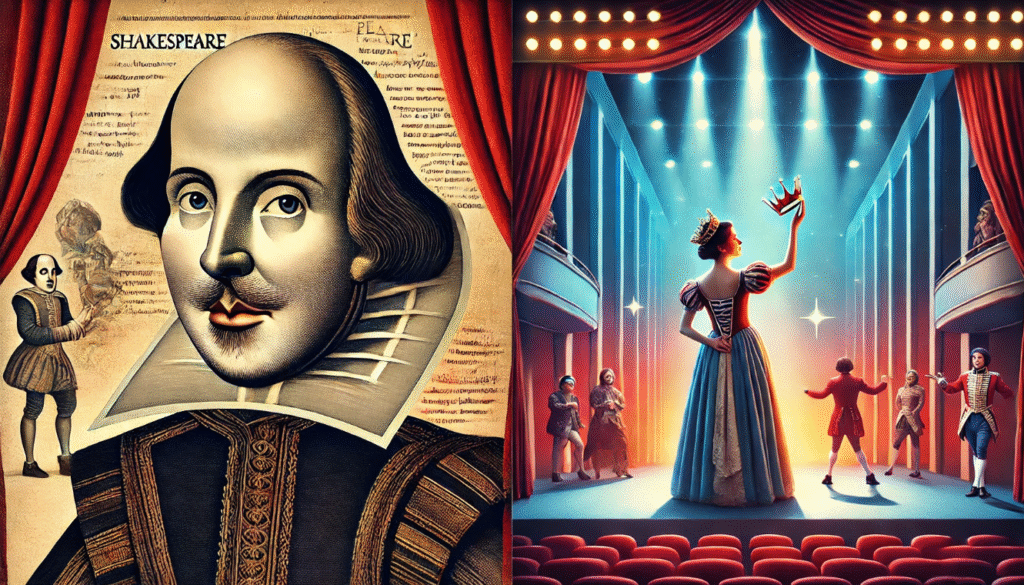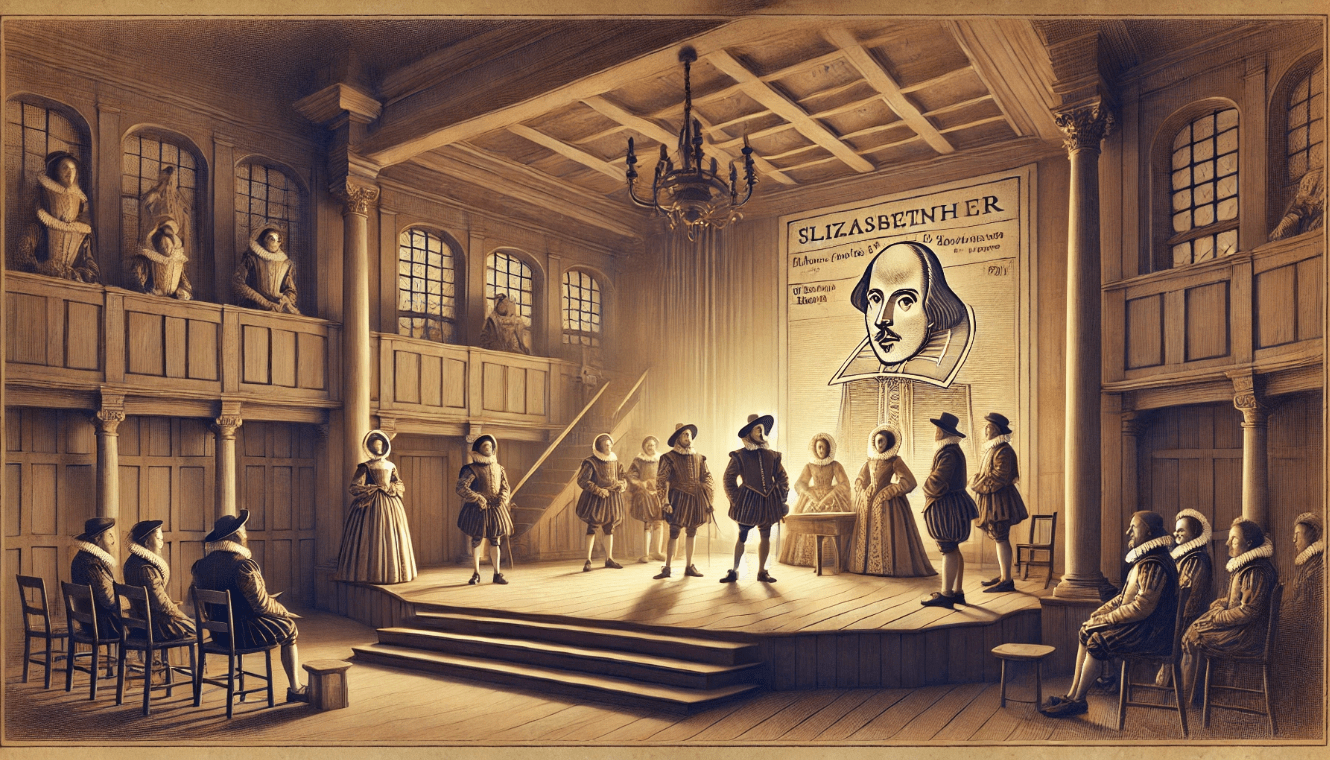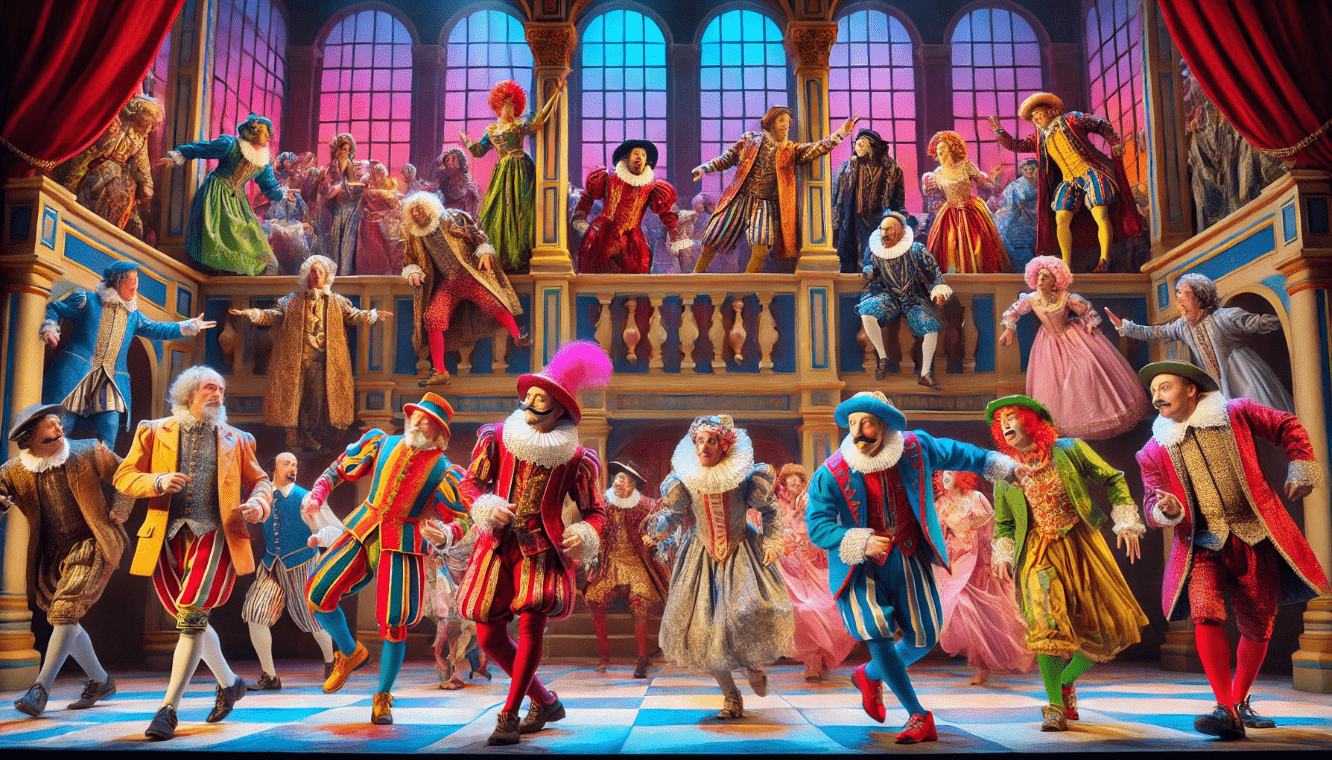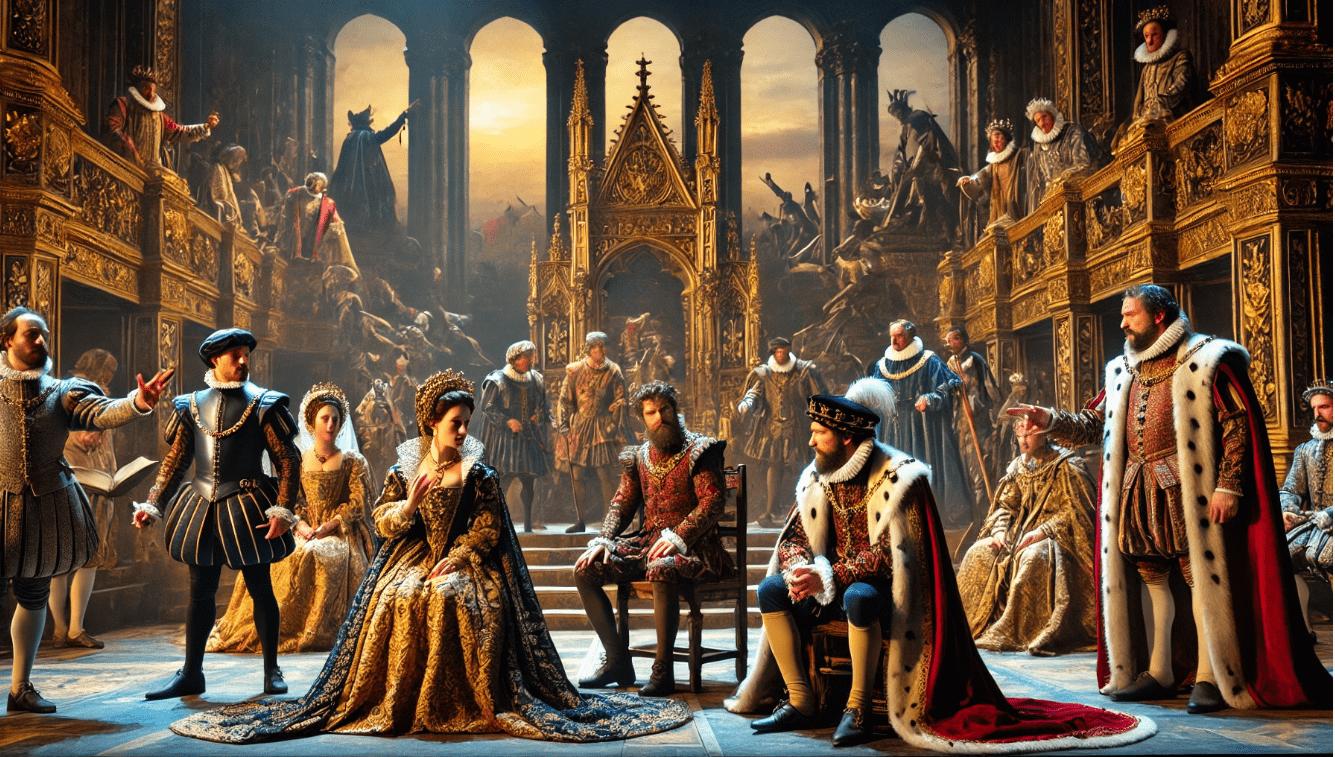
Understanding the Evolution of Shakespearean Dramatic Forms: How They Shaped Modern Theater
Shakespeare’s influence on modern theater is undeniable, but have you ever wondered how his dramatic forms evolved over time? 🎭 From his early plays to the masterpieces we know today, the evolution of Shakespearean dramatic forms transformed not just his work but the entire landscape of theater. Understanding this progression can help you unlock deeper meanings in his plays and even inspire your own creative work, whether you’re a writer, director, or theater enthusiast.
In this article, we’ll explore how Shakespeare’s dramatic techniques—like character development, complex plots, and groundbreaking use of language—shaped the very fabric of modern theater. Whether you’re new to Shakespeare or looking to deepen your understanding, this journey through his evolving dramatic forms will give you practical insights into how his timeless influence continues to inspire today’s stage. Ready to discover how Shakespeare’s genius still echoes in contemporary plays? Keep reading! 😊
Table of Contents
Toggle1. The Birth of Shakespearean Drama

When we think of Shakespeare, we often imagine grand tragedies or comedies full of mistaken identities and witty wordplay. However, the birth of Shakespearean drama was far from an overnight phenomenon—it evolved over time, shaped by the world around him. 🌍
In his early years as a playwright, Shakespeare was influenced by the rich history of Elizabethan theater, which included traditional morality plays, medieval mysteries, and Greek and Roman classics. These early forms were often simple in structure, relying on clear-cut plots with moral lessons. Shakespeare’s first plays, such as The Taming of the Shrew and Henry VI, were grounded in these traditions, but he began adding his unique twist. 🎭
Key Features of Early Shakespeare Plays:
- Simpler Plots: Early plays often focused on straightforward stories, whether comedies, tragedies, or histories.
- Strong Dialogue: Much of the action took place through clever, dynamic dialogue. Characters revealed themselves through monologues and witty exchanges rather than elaborate staging.
- Moral Themes: Plays like The Taming of the Shrew explored gender roles, while Henry VI delved into themes of power, politics, and war.
Shakespeare’s Early Innovations:
Even in his early works, Shakespeare began experimenting with the balance between action and dialogue. He understood that a strong narrative didn’t just rely on what happened, but also on how the characters spoke and reflected on events. This is where Shakespeare set himself apart from his contemporaries: his mastery of language became his dramatic signature. ✨
- Complex Characters: Shakespeare was one of the first to show a deep psychological layer in his characters, laying the foundation for the complex personalities that would appear in his later works.
- Breaking the Mold: While early plays stuck to basic dramatic forms, Shakespeare started to break free, mixing genres and giving his characters more personal agency.
2. The Rise of Complex Structures in Shakespeare’s Tragedies
As Shakespeare’s career progressed, so did his mastery of dramatic forms. One of the most notable shifts was the rise of complex structures in his tragedies. Plays like Macbeth, Hamlet, and King Lear introduced a depth and intricacy that went far beyond his earlier works. These plays not only focused on the events unfolding on stage but also delved deeply into the human psyche, exploring moral dilemmas, personal flaws, and the consequences of ambition. 🧠

The Shift from Simplicity to Complexity
In his earlier plays, Shakespeare relied on straightforward plots, often drawing from history or mythology. However, in his tragedies, he began to introduce multiple layers of meaning, often blurring the line between external events and internal conflicts.
- Moral and Psychological Depth: Characters like Hamlet and Macbeth are not just driven by external circumstances, but by internal struggles—guilt, fear, ambition, and madness. These complex psychological portrayals made his tragedies far more relatable and intense.
- Multiple Subplots: Tragedies like King Lear use subplots to parallel and contrast the main narrative, deepening the thematic impact. The storylines may seem separate at first but eventually tie together, adding layers to the central conflict.
Key Features of Shakespearean Tragedies:
- The Tragic Hero: Central to these tragedies is the tragic hero, a character who has a fatal flaw or makes a significant error in judgment. This flaw leads to their downfall, making the play both cathartic and tragic for the audience. For example, Macbeth’s unchecked ambition and Hamlet’s indecision lead to their inevitable demise.
- Complex Language: Shakespeare’s use of soliloquies, like Hamlet’s famous “To be or not to be,” gave characters a platform to express their internal struggles, making their emotions and thoughts accessible to the audience. This was a revolutionary way to engage the audience in a character’s journey.
- Interwoven Themes: Shakespeare’s tragedies explore complex themes like power, fate, morality, and identity. Each play allows for deep philosophical exploration, encouraging audiences to reflect on their own values and choices.
Why This Matters Today:
Shakespeare’s use of complex structures in his tragedies changed how stories were told. By intertwining internal and external conflicts, he created more layered, compelling characters, setting a standard for modern storytelling. This is still visible in today’s movies, TV shows, and plays, where complex protagonists often drive the plot.
For anyone looking to write or perform tragedy, understanding this shift in structure is key. It’s not just about what happens to the characters, but why they do what they do, and the psychological and emotional journey they undergo. This deepens the story and makes the audience care more about the outcome. 🎭
3. Shakespeare’s Comedies: The Art of Twists and Turns

Shakespeare’s comedies are not just about laughs—they are masterful examples of how to create engaging, multi-layered stories that keep audiences on their toes. Through twists and turns, mistaken identities, and clever dialogue, his comedies offer both humor and insight into human nature. Plays like A Midsummer Night’s Dream and Twelfth Night showcase his brilliant ability to blend fantasy, romance, and social commentary. 🌟
What Makes Shakespearean Comedy Unique?
At first glance, Shakespeare’s comedies might seem lighthearted, but beneath the surface, they tackle complex social themes such as love, class, and identity.
- Mistaken Identities and Disguises: One of the most prominent features in Shakespeare’s comedies is the use of disguise and mistaken identity. Characters often assume false identities, leading to misunderstandings and comedic chaos. This creates opportunities for humor while also exploring deeper themes of self-perception and societal roles.
- The Role of Love: Love is often the central theme, but Shakespeare portrays it in all its complexities—romantic love, unrequited love, and even love that defies social expectations. The love stories in plays like Much Ado About Nothing and Twelfth Night are filled with both humor and tension, drawing the audience into the emotional journey.
- Social Hierarchy and Class: Shakespeare uses comedy as a lens to explore social norms and class divisions. Whether it’s a servant outwitting a master or an aristocrat falling in love with a commoner, his comedies often challenge the traditional social order in a way that invites both humor and reflection.
How Shakespeare Shaped Modern Comedy
Shakespeare’s comedic style continues to influence modern storytelling, especially in romantic comedies and sitcoms. The art of twists and turns in his plots laid the groundwork for the unpredictable humor that we enjoy today.
- Layered Humor: Shakespeare’s use of wordplay and puns, especially in characters like Feste from Twelfth Night, creates a humor that is witty, sophisticated, and often profound. This type of humor has influenced everything from classic sitcoms to modern comedic films.
- Character Archetypes: The use of stock characters—like the witty servant, the naive lover, or the wise fool—became a staple in modern comedy. These archetypes are still seen in many contemporary works, from film to television.
- Unexpected Endings: Shakespeare’s comedies often end with joyful resolutions, but they are rarely simple. The twists in the plot keep the audience guessing until the very end, ensuring that the final moments are both satisfying and unexpected. This unpredictability is a key element in today’s comedy.
Practical Takeaways for Writers and Performers:
If you’re a writer or performer looking to create your own comedy, here are a few practical lessons from Shakespeare’s comedic works:
- Play with Identity: Use mistaken identities or disguises to create tension and humor. Think about how characters’ perceptions of themselves and each other can lead to funny situations.
- Mix Romance with Conflict: Romantic tension is at the heart of many comedies. Pair it with misunderstandings or societal pressure to add layers to your story.
- Challenge Norms: Use humor to explore and question societal norms, whether it’s class, gender, or love. Comedy is a great way to offer subtle commentary on serious issues without losing the audience’s attention.
4. History Plays: Shakespeare’s View of Power and Politics
Shakespeare’s history plays offer a fascinating window into his views on power, politics, and leadership. By dramatizing the lives of English monarchs and pivotal moments in history, Shakespeare explored the complexities of authority, ambition, and the personal toll of ruling a kingdom. Plays like Richard III, Henry IV, and Henry V are not just historical retellings—they’re rich, political commentaries that remain relevant even today. 👑

The Political Landscape of Shakespeare’s History Plays
Shakespeare wrote his history plays during a time of political instability in England, including the rise of the Tudor dynasty. His plays reflect both the historical context of his time and his personal views on power. However, Shakespeare didn’t simply recount history; he reshaped it, using the past to explore timeless themes of leadership and the human condition.
- The Nature of Power: Shakespeare’s history plays explore the complexities of power—how it’s acquired, maintained, and lost. In Richard III, we see a villainous king who manipulates and murders his way to the throne, only to lose everything in the end. In contrast, Henry V presents a king who rises to greatness through leadership and military triumph but is also burdened by the weight of his responsibilities.
- The Burden of Leadership: Shakespeare often portrays rulers as deeply flawed individuals. While powerful, they are not immune to doubt, regret, or personal tragedy. For example, Henry IV in Henry IV struggles with his past and his role as a father and king, while Richard II wrestles with the legitimacy of his reign.
- Political Intrigue and Betrayal: Shakespeare’s history plays are full of betrayal, conspiracies, and shifting allegiances. These plots highlight the fragility of power and the dangers of ambition. Characters who seek the throne through deceit, like Richard III or even the plotting of Edmund in King Lear, show the lengths individuals will go to for power.
Why Shakespeare’s History Plays Matter Today
While Shakespeare wrote his history plays centuries ago, their exploration of power, politics, and leadership is still deeply relevant. Here’s why these plays still matter in the modern world:
- Relevance to Contemporary Politics: Shakespeare’s portrayal of power struggles, political manipulation, and leadership challenges mirrors many of today’s political landscapes. His plays help us understand how ambition and personal flaws can shape the course of history. In today’s world, political figures often face similar dilemmas about power and the ethics of leadership.
- Timeless Lessons on Leadership: Shakespeare’s history plays offer valuable lessons for modern leaders. The complexities of leadership in plays like Henry V teach us about the balance between strength, compassion, and the responsibility of holding power. Henry’s famous speech before the Battle of Agincourt remains an inspirational model of leadership and resilience.
How to Apply Shakespeare’s Political Insights
For those interested in politics, leadership, or even storytelling, Shakespeare’s history plays offer practical lessons on power dynamics and leadership strategies:
- Understand the Burden of Power: Leaders are often depicted as facing personal challenges and moral dilemmas that shape their decisions. Recognize that leadership comes with responsibility and self-reflection.
- Beware of Ambition’s Dangers: Shakespeare shows us how unchecked ambition can lead to downfall. In both politics and business, balance ambition with ethical considerations and long-term thinking.
- The Role of Legacy: The history plays frequently explore the lasting consequences of rulers’ actions. In modern contexts, think about the impact your decisions will have on the future—whether in politics, business, or personal life.
5. The Use of Language in Shakespeare’s Dramatic Forms
Shakespeare’s language is often seen as one of his greatest achievements. But what makes his use of language so powerful? His ability to weave emotion, meaning, and rhythm into every line transformed the way we understand and appreciate drama. Shakespeare’s use of language in his dramatic forms wasn’t just for beauty—it was a tool to explore the depths of human experience. ✨

The Power of Soliloquies and Monologues
One of Shakespeare’s most innovative contributions to drama is the soliloquy, where a character speaks directly to the audience, revealing their inner thoughts. This tool allows the audience to engage deeply with the character’s emotional and psychological state.
- Insight into Character’s Mind: Characters like Hamlet and Macbeth are given soliloquies that let us explore their complex inner struggles. For example, Hamlet’s “To be or not to be” speech explores existential questions about life and death, while Macbeth’s soliloquies reveal his spiraling ambition and guilt.
- Creating Connection: Soliloquies make the audience feel like they are inside the character’s mind, building a stronger emotional connection and understanding of their motivations.
Use of Wordplay and Puns
Shakespeare was a master of wordplay, using puns, double meanings, and clever language to add depth to his plays. His use of language was not just about getting a point across but also about enriching the meaning through layers of interpretation.
- Layered Meaning: Puns and wordplay can make Shakespeare’s plays both humorous and thought-provoking. For instance, in Twelfth Night, characters frequently use wordplay to create humor while subtly commenting on the themes of love, disguise, and identity.
- Double Entendres: Shakespeare often layered his dialogues with double meanings—what seems like a simple joke might carry deeper themes of love, power, or social norms.
Poetic and Imagery-Rich Language
Shakespeare’s ability to create vivid images and emotional landscapes through his language is unmatched. Whether describing the beauty of nature or the horror of war, his use of metaphors, similes, and rich imagery brings his plays to life.
- Building Atmosphere: The language in Macbeth, for example, uses dark, foreboding imagery to enhance the play’s theme of guilt and supernatural forces. Descriptions of blood, ghosts, and witches heighten the sense of dread, making the audience feel the weight of Macbeth’s actions.
- Evoking Emotion: Shakespeare’s poetic language can make emotions like love, grief, or anger more palpable. When Juliet speaks of her love for Romeo, her poetic language elevates the romance to a transcendent level, making the audience feel her passion and longing.
Why This Matters Today
Shakespeare’s unique use of language doesn’t just hold historical value—it continues to impact modern theater and media. His ability to blend poetic beauty with deep human emotion sets a standard for writers today. Whether in film, TV shows, or modern theater, the influence of Shakespeare’s language can be seen in how characters are written and how stories unfold.
- Enhancing Emotional Depth: Writers today still use Shakespeare’s techniques to create emotional depth in characters. By understanding how to blend dialogue with character psychology, modern playwrights can develop more complex, relatable characters.
- Engaging Audiences: Shakespeare’s language draws audiences in by making them feel connected to the character’s inner world. This is a lesson for modern content creators, reminding them that good dialogue can create engagement that resonates long after the performance ends.
How You Can Apply Shakespeare’s Language Techniques
If you’re a writer or aspiring playwright, here’s how you can incorporate Shakespeare’s language techniques into your own work:
- Use Soliloquies for Emotional Depth: Allow your characters to speak directly to the audience. Let their inner struggles and desires shape their actions and connect with the audience on a deeper level.
- Play with Words: Don’t be afraid to use wordplay and double meanings. Create humor or tension through clever dialogue that offers more than one interpretation.
- Create Vivid Imagery: Paint pictures with your words. Use metaphors, similes, and vivid descriptions to enhance your storytelling and evoke emotion.
Shakespeare’s use of language wasn’t just for style—it was a powerful tool for storytelling. By examining how he used language to explore complex characters and themes, we can better appreciate the depth and richness of his work—and apply those insights to our own creative endeavors. 🎭✨
6. The Influence of Shakespeare on Modern Theater
Shakespeare’s impact on modern theater is immeasurable. His dramatic forms, character development, and themes continue to shape plays, films, and TV shows today. From complex plots to relatable characters, the influence of Shakespearean drama is still felt on stages worldwide. 🎭
Shakespeare’s Lasting Legacy in Modern Playwriting

One of the most significant ways Shakespeare continues to influence modern theater is through his storytelling techniques.
- Complex Characters and Human Psychology: Shakespeare’s ability to create multi-dimensional characters has influenced modern playwrights who focus on portraying complex human emotions. Characters in contemporary plays and movies often wrestle with similar internal conflicts, ambitions, and moral dilemmas as Shakespeare’s tragic heroes, such as Hamlet or Macbeth.
- Layered Narratives and Subplots: Shakespeare was a master at weaving multiple storylines and characters into a single narrative. This technique of using subplots that complement or contrast with the main story can be seen in modern works, particularly in drama and sitcoms.
Modern Adaptations of Shakespeare’s Plays
Shakespeare’s works have not only been performed in their original form but have also been reimagined in contemporary settings, proving their timeless relevance.
- Film and TV Adaptations: Movies like West Side Story (based on Romeo and Juliet) or 10 Things I Hate About You (inspired by The Taming of the Shrew) show how Shakespeare’s themes of love, conflict, and misunderstanding continue to resonate with audiences. These modern adaptations keep the essence of his plays but transport them into different cultural contexts.
- Musicals and Contemporary Theater: Broadway shows such as Hamilton have used Shakespeare’s approach of blending history with drama, creating a hybrid form that appeals to modern sensibilities. Similarly, experimental theaters continue to reinterpret his works, mixing genres and media to explore the same themes Shakespeare tackled.
Shakespeare’s Influence on Modern Performance Techniques
Shakespeare’s influence extends beyond the script. His innovative use of language and performance techniques still impacts actors and directors today.
- Soliloquies and Direct Address: Shakespeare pioneered the use of soliloquies and direct address to the audience. Modern actors still use soliloquies to reveal a character’s inner thoughts and dilemmas. This direct connection with the audience remains a powerful tool in both theater and film.
- Language and Wordplay: The clever use of language—puns, metaphors, and wordplay—introduced by Shakespeare is still a hallmark of modern theater. Today’s playwrights often borrow these techniques to add layers of meaning to their dialogue, just as Shakespeare did.
Why Shakespeare Still Matters Today
Shakespeare’s relevance in modern theater lies in his ability to speak to universal human experiences. His exploration of love, power, ambition, and identity transcends time and place, making his work endlessly adaptable.
- Universal Themes: Shakespeare’s themes of love, ambition, betrayal, and redemption resonate just as strongly today as they did in the Elizabethan era. These universal themes are at the heart of many modern productions and remain timeless in their emotional appeal.
- Cultural Adaptability: Shakespeare’s works have been adapted across cultures, languages, and mediums, showing their adaptability and universal appeal. His ability to bridge historical and cultural gaps ensures that his plays will continue to be relevant for generations to come.
How You Can Apply Shakespeare’s Influence
If you’re a playwright, director, or actor looking to harness Shakespeare’s influence, here’s how you can apply his techniques:
- Develop Complex, Relatable Characters: Like Shakespeare, focus on developing characters with depth. Create flaws and inner conflicts that the audience can empathize with.
- Use Language Creatively: Incorporate clever wordplay, metaphor, and imagery to deepen the meaning in your scripts.
- Experiment with Structure: Borrow from Shakespeare’s layered plot structure and intertwine subplots to enhance the complexity of your narrative.
Shakespeare’s influence on modern theater is undeniable and still felt across the world. Whether through adaptations of his works or the techniques he pioneered, his impact continues to shape the way stories are told on stage and screen. 🌟
7. How to Apply Shakespearean Dramatic Forms in Modern Playwriting and Performance

Shakespeare’s dramatic forms are timeless, offering powerful tools for modern playwriting and performance. Whether you’re an aspiring playwright or an actor looking to deepen your craft, learning how to apply these forms can elevate your work. Let’s explore how you can incorporate elements of Shakespearean drama into your own creative process. 🎭✨
1. Develop Complex Characters
One of Shakespeare’s most notable achievements was his ability to create characters with depth—people who are driven by internal conflict, personal flaws, and complicated emotions. Modern playwrights can learn a lot from his character-building techniques.
- Focus on Flaws and Inner Conflict: Just like Hamlet’s indecision or Macbeth’s unchecked ambition, create characters whose internal struggles drive the plot forward. This not only makes characters more relatable but also creates a more engaging narrative.
- Use Soliloquies to Reveal Emotions: Shakespeare’s soliloquies allow characters to speak directly to the audience, offering insight into their inner lives. This is a powerful tool for making characters’ thoughts and feelings clear to the audience without relying on dialogue alone.
2. Master the Art of Layered Storytelling
Shakespeare’s use of multiple storylines and subplots added depth and complexity to his plays. Modern writers can take inspiration from this by weaving together interconnected plotlines that enhance the main story.
- Create Parallel Narratives: Like King Lear or A Midsummer Night’s Dream, consider using subplots that reflect or contrast with the main plot. This adds richness and helps reinforce the main themes of your play.
- Ensure Subplots Are Purposeful: Every subplot should contribute to the overall theme or character development. Don’t use subplots just for filler—make sure they add meaning and complexity.
3. Use Language to Add Depth
Shakespeare’s mastery of language is one of his most enduring legacies. His plays are rich in metaphor, wordplay, and poetic dialogue, which elevate the emotional and intellectual impact of his work. Here’s how you can apply that:
- Play with Words: Use puns, double meanings, and clever wordplay to give your dialogue layers of meaning. Just like Shakespeare did, use language to reflect a character’s state of mind or to add humor or tension.
- Craft Memorable Monologues: Shakespeare’s monologues are often central to his plays because they give characters a chance to articulate their deepest thoughts. Incorporate long, introspective speeches to reveal your characters’ motivations and emotional struggles.
4. Explore Timeless Themes
Shakespeare’s works often explore universal themes like love, ambition, power, and betrayal. These themes are as relevant today as they were in his time and can add emotional weight to your writing.
- Revisit Classic Themes: Don’t be afraid to tackle themes that Shakespeare explored, like the corrupting nature of power (Macbeth), the complexities of love (Romeo and Juliet), or the consequences of betrayal (Julius Caesar). These themes resonate with modern audiences and can provide a solid foundation for your story.
- Make It Personal: While exploring timeless themes, make sure to ground them in personal, relatable experiences. Modernize these themes in a way that reflects current societal issues or personal struggles, just as Shakespeare’s work often commented on the politics and social issues of his time.
5. Experiment with Structure and Form
Shakespeare played with the structure of his plays, often blending genres or bending traditional forms to suit his storytelling needs. You can take inspiration from this flexibility in your own writing.
- Mix Genres: Shakespeare famously mixed tragedy and comedy (e.g., The Merchant of Venice) or history and romance (e.g., Henry V). Feel free to blend genres to create a more dynamic experience for your audience.
- Challenge Traditional Structures: Break away from traditional three-act structures. Shakespeare’s plays often don’t follow a predictable pattern, so play around with pacing, timing, and act breaks to keep your audience on their toes.
6. Bring Shakespeare’s Theatricality to Life
Shakespeare’s plays were meant to be experienced live, with rich performances that engaged the audience. Modern theater directors can incorporate this spirit of theatricality into their productions.
- Engage the Audience: Shakespeare’s use of direct address (soliloquies) and asides to the audience created a sense of intimacy. Use this technique to involve your audience in the action, making them feel connected to the characters’ journeys.
- Focus on Physicality and Emotion: Shakespeare’s actors used their physical presence to convey meaning, as much of the emotional weight came from performance rather than just dialogue. Make sure your performances focus on the physical and emotional aspects of the characters.
7. Adapt Shakespeare for Contemporary Audiences
While Shakespeare’s plays were written for a specific time and place, their themes and structures are universal. To keep his works relevant today, it’s important to adapt them thoughtfully.
- Modernize the Setting: You can retain the core elements of Shakespeare’s plays while updating the setting or cultural context. For example, adapting Romeo and Juliet to a modern city with contemporary issues can make it feel fresh without losing its emotional core.
- Speak to Today’s Issues: Shakespeare’s works often dealt with issues of power, class, and identity. Address similar issues that resonate with today’s audiences, such as social justice, inequality, or identity politics, while staying true to the timeless themes of Shakespeare’s works.
Shakespeare’s dramatic forms revolutionized the world of theater, and their influence continues to shape modern storytelling today. From his complex characters to his innovative use of language, Shakespeare set a standard for how plays should engage audiences on both an intellectual and emotional level. By understanding the evolution of his dramatic techniques, you can unlock a deeper appreciation for his work—and apply these timeless principles to your own creative endeavors. 🎭✨
Whether you’re a playwright looking to develop layered narratives, an actor seeking to bring depth to your performance, or a theater enthusiast eager to understand the roots of modern drama, Shakespeare’s influence is invaluable. His exploration of universal themes, intricate character development, and mastery of language offers insights that still resonate across centuries.
By incorporating Shakespeare’s techniques—such as multi-dimensional characters, layered plots, and poetic language—into your own work, you can continue to build upon the legacy of one of the greatest storytellers in history. Shakespeare’s dramatic forms are not just historical artifacts; they are living, breathing tools for today’s theater and beyond. 🌍🎭
Frequently Asked Questions (FAQs)
1. What are Shakespearean dramatic forms?
Shakespearean dramatic forms refer to the various structures and styles used by Shakespeare in his plays, including tragedy, comedy, history, and romance. These forms often explore complex human emotions, power dynamics, and societal themes, with innovative use of language and character development.
2. How did Shakespeare influence modern theater?
Shakespeare revolutionized theater by introducing complex characters, layered plots, and sophisticated language. His plays set the foundation for modern storytelling, from intricate subplots to psychological character development, which can be seen in contemporary drama, film, and television.
3. What is the difference between Shakespeare’s tragedies and comedies?
Shakespeare’s tragedies typically deal with themes of fatal flaws, power, and downfall (e.g., Macbeth and Hamlet), whereas his comedies focus on romantic misunderstandings, mistaken identities, and happy resolutions (e.g., Twelfth Night and A Midsummer Night’s Dream).
4. Why are soliloquies important in Shakespeare’s plays?
Soliloquies are significant because they give characters the opportunity to express their inner thoughts and conflicts directly to the audience. They help reveal a character’s motivations and emotions, making the audience feel more connected to their journey.
5. How can modern playwrights use Shakespeare’s dramatic techniques?
Modern playwrights can apply Shakespeare’s techniques by creating multi-dimensional characters with complex emotions, using layered storylines, and incorporating rich, poetic language. They can also experiment with mixing genres, like Shakespeare did with his tragedies and comedies.
6. What themes from Shakespeare's plays are still relevant today?
Shakespeare’s themes, such as love, ambition, power, betrayal, and identity, are timeless and continue to resonate with contemporary audiences. These themes explore universal human experiences, making his works relatable across generations.
7. How did Shakespeare use language to enhance his plays?
Shakespeare’s use of language was both poetic and precise, employing metaphors, puns, and rich imagery to convey deeper meanings. His creative wordplay added layers of complexity to his characters and themes, making his works engaging on multiple levels.
8. How can I adapt Shakespeare’s works for modern audiences?
To adapt Shakespeare’s works, you can update the setting or language while maintaining the core themes and character dynamics. Modern adaptations, such as West Side Story or 10 Things I Hate About You, show how Shakespeare’s timeless stories can be reinterpreted for today’s culture.
